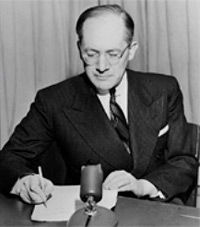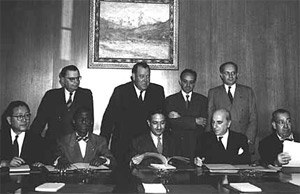The Convention on the Prevention and Punishment of the Crime of Genocide was adopted by the United Nations General Assembly in December 1948 and came into effect in January 1951. It defines genocide in legal terms, and is the culmination of years of campaigning by lawyer Raphael Lemkin, who coined the term by reference to the Assyrian massacre, the Holocaust, and the Armenian Genocide. All participating countries are advised to prevent and punish actions of genocide in war and in peacetime. The number of states that have ratified the convention is currently 137.
 Raphael Lemkin
Raphael Lemkin
(1900-1959)
Raphael Lemkin was born in Bezwodene, Poland (now near Volkovysk, Belarus), on June 24, in 1900. Lemkin mastered nine languages by the age of 14, including French, Spanish, Hebrew, Yiddish, and Russian.
After graduating from a local trade school in Bialystok he began to study linguistics at the John Casimir University in Lvov. It was there that Lemkin became interested in the concept of the crime, which later was involved into the idea of genocide, starts with concern over the unpunished Turkish massacre of hundreds of thousands of Armenians. The Turkish official who ordered the massacre was not brought to trial but the young man who allegedly assassinated him was.
Lemkin then moved on to the University of Heidelberg in Germany to study philosophy, and returned to Lvov to study law in 1926, becoming a prosecutor in Warsaw at graduation.
Lemkin died in New York City in 1959, at the age of 59. In an ironic final twist for a man whose life was dedicated to the remembrance of millions of victims of genocide, seven people attended his funeral.
After the World War II, Lemkin remained in exile in the United States. From 1948 onward he gave lectures on criminal law at the Yale University. Lemkin also continued his campaign for international laws defining and forbidding genocide, which he had championed ever since the Madrid conference of 1933. He proposed a similar ban on crimes against humanity during the Paris Peace Conference of 1945, but his proposal was turned down.
Lemkin presented a draft resolution for a Genocide Convention treaty to a number of countries in an effort to persuade them to sponsor the resolution. With the support of the United States, the resolution was placed before the General Assembly for consideration. In 1951, Lemkin only partially achieved his goal when the Convention on the Prevention and Punishment of the Crime of Genocide came into force, after the 20th nation had ratified the treaty. This treaty had confined its consideration solely to physical aspects of genocide which The Convention defines as:
…any of the following acts committed with intent to destroy, in whole or in part, a national, ethnical, racial or religious group, such as:
- Killing members of the group;
- Causing serious bodily or mental harm to members of the group;
- Deliberately inflicting on the group conditions of life calculated to bring about its physical destruction in whole or in part;
- Imposing measures intended to prevent births within the group;
- Forcibly transferring children of the group to another group.
Lemkin's broader concerns over genocide, as set out in his "Axis Rule in Occupied Europe", also embraced what may be considered as non-physical, namely, psychological acts of genocide which he personally defined as:
- "Generally speaking, genocide does not necessarily mean the immediate destruction of a nation, except when accomplished by mass killings of all members of a nation. It is intended rather to signify a coordinated plan of different actions aiming at the destruction of essential foundations of the life of national groups, with the aim of annihilating the groups themselves. The objectives of such a plan would be disintegration of the political and social institutions, of culture, language, national feelings, religion, and the economic existence of national groups, and the destruction of the personal security, liberty, health, dignity, and even the lives of the individuals belonging to such groups. Genocide is directed against the national group as an entity, and the actions involved are directed against individuals, not in their individual capacity, but as members of the national group."
- "Genocide has two phases: one, destruction of the national pattern of the oppressed group; the other, the imposition of the national pattern of the oppressor. This imposition, in turn, may be made upon the oppressed population which is allowed to remain or upon the territory alone, after removal of the population and the colonization by the oppressor's own nationals."
 Photo by United States Holocaust Memorial Museum
Photo by United States Holocaust Memorial MuseumPUBLISHED IN 1948
Extract from “The Beginnings of Genocide: An account of the Armenian Massacres in World War I” by Joseph Guttmann published in 1948, in a year of the adoption of the UN Convention
THE BEGINNINGS OF GENOCIDE
The wholesale extermination of six million Jews is rightly considered the greatest single crime of our time. A special scientific term, "genocide", was invented to charac-terize the organized attempt to exterminate a whole ethnic group. And one thought that such a crime had never been attempted in modern times.
But this is not quite correct. The Nazis organized the mass killing on an unheard of scale and with a "scientific" brutality without precedent. But there had already been a grandiose attempt to exterminate a whole nation in our "enlightened" century. It took place, if not directly in Eu-rope, at its very gates, and the victims were not members of some "savage tribes", but of a civilized Christian nation. If the methods of murder, compared with the "scientific" efficiency of the Nazis, look rather primitive (gas-chambers were not yet known at that time), still we see there all the elements which were later so much "perfected" by the Nazis: There was a well-prepared plan for action; co-ordinated operations of an entire administration, directed by a powerful party machine; government-inspired attempts to incite mobs to violence; assassination of all men who would be able to resist; destruction of families, sep-aration of men from women, of children from parents; mass deportations under conditions in which most of the de-portees died on their way; the liquidation of the rest in remote regions in concentration camps or during "death marches."
The Background
Some readers will already have guessed what I have in mind: the Turkish atrocities against the Armenians thirty years ago. But some will have to admit that they did not think of it. And that is the tragedy of our times. We for-get too quickly. Yesterday, the victims were "only" Arme-nians; today, "only" the Jews — but also Poles and other European peoples. And who will be tomorrow?...
Translated from Yiddish: Yivo Bleter. The Journal of the Yiddish Scientific Institute. Vol. XXVIII. No. 2. 1948.
Sources:
“The Criminal Law of Genocide: International, Comparative and Contextual Aspects” edited by Ralph Henham and Paul Behrens
http://www.preventgenocide.org/lemkin/
http://en.wikipedia.org/wiki/Raphael_Lemkin
http://www.ushmm.org/conscience/history/lemkin/
Downloading the full text of the Resolution on Convention on the Prevention and Punishment of the Crime of Genocide in English. Click on download.
Downloading the full text of the Resolution on Convention on the Prevention and Punishment of the Crime of Genocide in Russian. Click on download.
Downloading the full text of the Resolution on Convention on the Prevention and Punishment of the Crime of Genocide in French. Click on download.





